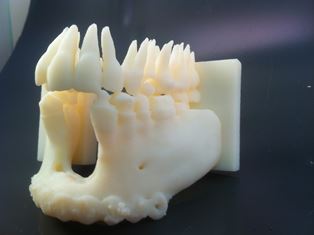Twelve NHS hospitals use 3D printing to test implants for reconstructive surgery
26 August 2014
Stratasys Ltd has announced that UK medical 3D printing specialist, Replica 3DM, is using its Stratasys 3D Printers to provide a service to twelve NHS hospitals to print models for the validation of reconstructive implants prior to surgery.
The 3D modelling is having a significant impact on the length of surgical procedures and leading to substantial reductions in theatre costs.
Replica 3DM's Stratasys Objet24 and Objet30 Pro 3D Printers convert patient CT scans into physical 3D printed models that are used as surgical guides to test implants for size and fit pre-surgery. This includes re-bending of titanium implant plates to the patient's exact specifications and preoperative investigations across maxillofacial, orthopedics, neurology, spinal and ears, nose and throat wards, to identify the correct procedure and improve outcome.
The company also produces a number of cranioplasty models in which the unaffected side of the patient's face is mirrored to produce a 3D printed reconstruction, prior to the fitting and placement of a titanium plate.
Originally established as a 3D modelling department of Salisbury District Hospital, Replica 3DM has since extended its medical 3D printing capabilities to NHS hospitals across the UK, primarily offering its services to trusts that do not have in-house access to 3D printers.
"To us, 3D printing and the medical profession go hand-in-hand, particularly in the planning of complicated procedures," explains Matthew Sherry, Managing Director and Founder of Replica 3DM. "A 3D model equips surgeons with a hands-on perspective which cannot be achieved by looking at a computer screen. They can easily rotate, inspect and analyze each surgical procedure on a case-by-case basis, enabling them to pre-bend implants knowing that they will perfectly fit the patient. This is instrumental in eliminating potential problems during operations and can be used as a visual aid when explaining the surgical procedure to patients."


Examples of 3D printing
According to Matthew Sherry, the ability to use 3D printed models to pre-bend titanium implants has reduced surgery time significantly.
"In the past, surgeons would depend on surgical experience to fit the plates during surgery. This could not only be quite costly, it may also crucially require longer patient anaesthesia times," he explains. "As demonstrated in a recent maxillofacial procedure at Salisbury District Hospital, the ability to pre-bend the titanium plate prior to surgery enabled surgeons to secure the perfect custom fit. This reduced the number of incisions required and overall theatre time, directly impacting the quality of patient care.
"With theatre typically costing around £3,600 an hour, you can imagine how much we save NHS Trusts. In most cases, a model will pay for itself and helps with essential pre-operative surgical planning."
Chris Baker, Stratasys Northern European Territory Manager, explains: "In an industry where precision is paramount, the ability to produce highly accurate 3D printed surgical models and guides that mimic the look and feel of titanium implants can both lower costs and reduce the time required for patients to be anesthetised. As a result, an increasing number of hospitals worldwide are integrating 3D printing into surgical planning procedures, which is having an immediate positive impact on the quality of patient treatment."